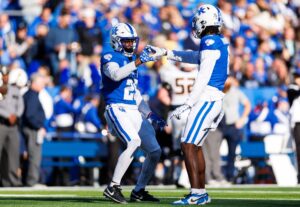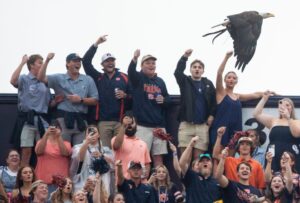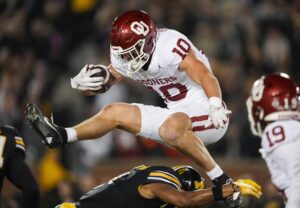A lot can be made of Saturday night’s UCLA vs. Arizona State game at the Rose Bowl in Pasadena. The coaches will tell you it is what is next on the schedule and that is it. But the match-up is not only for the top spot in the Pac-12 South at an early point in the season. It is also a quarterback match-up of once highly regarded dual threat recruits who are now near the top of their game going into Saturday. As both quarterbacks go, so goes their team.
ASU’s Daniels
ASU’s Jayden Daniels is the consummate dual threat quarterback. He has thrown for more than 800 yards this season at a 72% completion rate that is tied for first in the conference. But he has also run for 248 net yards and is getting just under 10 yards per carry.
We suggested to UCLA head coach Chip Kelly that it seemed as though Daniels was at his most dangerous when the play was not a designed run. “That’s a really good point,” Kelly said Wednesday. “That’s when he is at his best because he is such a quality athlete that you’ve got to make sure you know where he is at all times.”
Kelly described what he has seen on film with Daniels’ decisions to run. “It’s the unscheduled ones that can really hurt you. It may be a called pass play and so everybody is in coverage and matched up with whoever they are matched up with. And they may have five receivers out in the pattern. And then if the rushing lanes break down or the containment of the rush break down, then he’s really dangerous.” He said the UCLA defensive line keeping its assignment lanes is the only thing UCLA can do to combat that.
Sun Devils Running
The Sun Devils are also more of a run-oriented team than previous incarnations under head coach Herm Edwards. They average 211 yards per game on the ground. That is good enough for second in the conference and 23rd in the country.
Edwards said earlier in the week that it’s tough for a defense to practice and prepare for a quarterback who can have the high degree of unscripted runs that Daniels has. With that being the case, Daniels has a lot more latitude in using his adjustment to take off out of the pocket.
UCLA’s DTR
Edwards is keeping his eye on UCLA’s quarterback, Dorian Thompson-Robinson. His run game is more by design than is Daniels’. He had two rushing touchdowns last week in the win at Stanford, both straight out of the playbook. Edwards called UCLA’s offense, “Eye candy,” with all the shifts and motion. He said focus from his defensive front seven would be key. UCLA showed a different wrinkle in the offense last week, throwing to Zach Charbonnet and Brittain Brown out of the backfield. It forced the defense to widen out instead of allowing them to stack seven in the box the way Fresno State did the week before in shutting down UCLA’s run attack.
Paralysis By Stats Analysis
It also makes the passing game a little quicker in execution for Thompson-Robinson whose statistics are a weekly topic of debate, puzzlement, and unending analysis. He is now 12th in the country in passing efficiency. And thanks in large part to the higher-probability passing attack with the running backs last week, he has upgraded to 10th in the conference in completion percentage at 57%. It was only two weeks ago that he was dead last in the Pac-12. There is also the tale of the two halves of Thompson-Robinson’s game. In the first half of games this season, he has completed only 46% of his passes with one touchdown and one interception. In the second half of games, he has a 67% completion rate and has eight touchdown passes with no interceptions.
A Thompson-Robinson that ever puts two complete halves together could be one of the most dangerous quarterbacks in the country. But then what do two complete halves look like? No one questions Thompson-Robinson’s ability to throw downfield. His 75-yard touchdown pass to Kyle Philips in the second half last week could not have been more picture perfect. But the shorter, reaction-based passing game seems more suited to success because here is a stat that ranks among the stranger ones to analyze. UCLA is 3-7 when Thompson-Robinson throws for more than 250 yards in a game in his UCLA career.
Efficiency And Fixes
If we channel our inner-Chip Kelly, he would tell us that with a team that was 10-21 going into this season, UCLA was behind a lot and Thompson-Robinson had to air it out more. But that would bely the stat the team likes to put out about how close they were in games they lost. The Thompson-Robinson who spends too much of the game deep in the pocket, going through progressions, is not the more efficient Thompson-Robinson. And while he looked physically fine at practice this week, his throwing arm and shoulder took a beating last week.
With all of the shifts and motion in the offense that has Edwards concerned, it seems clear that the successful path going forward is the shorter, more efficient passing game. Against Stanford, the linebackers had to be concerned about running backs in pass patterns. That opened the middle of the field for tight end Greg Dulcich who nearly doubled his season catches in one game. That also allows for the occasional strikes downfield like the one to Philips.
Kelly said the offense has a lot of work to do still. “You’re always pleased but you’re not satisfied,” he said. “I think we left a lot on the bone against Stanford. We could have executed better in certain situations. I could have called better plays in certain situations.” Kelly said watching the game film on the plane ride home tends to bring a coaching staff down from the high of a win and back into the focus of what needs to be fixed.
Whichever of the quarterbacks plays two full halves of high production football is likely leading his team to a win, which makes the game film viewing a lot more palatable.






